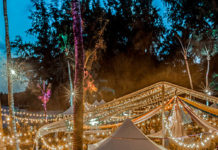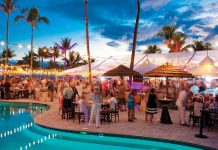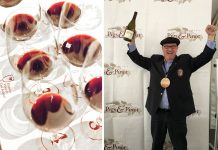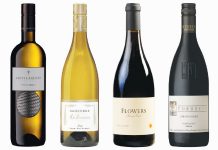Story by Charles Fredy
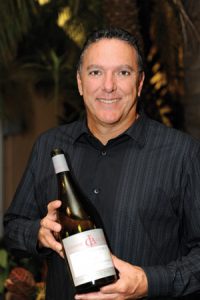 Nothing befits a holiday toast like champagne. What makes it special is also what makes it the most difficult wine to produce. It requires tremendous care and patience—and you literally have to make it twice.
Nothing befits a holiday toast like champagne. What makes it special is also what makes it the most difficult wine to produce. It requires tremendous care and patience—and you literally have to make it twice.
After the base wine is made, the liquor de triage (a yeast/sugar mixture) is added to the bottle to start a second fermentation. This doesn’t produce alcohol; it creates those signature bubbles—and nearly six atmospheres of pressure. (Now you know why champagne bottles are so thick!) Over time, this pressure compresses and refines the bubbles. In fact, one way to evaluate a champagne is to look at its effervescence. An inexpensive sparkling wine or champagne that hasn’t been aged long will have a larger bead, and won’t feel as delicate going down.
Hence, time spent in the cellar. A lot of time. Some champagne won’t see its first cork popped for ten years or more! While in the cellar, the bottle is riddled, or turned, every day for months. Eventually the bottle rests upside down, with the expended yeast collecting in the neck. This sediment is removed, and the bottle topped off with a reserve wine to which pure cane sugar and other ingredients have been added. Then the bottle is corked and the wine aged for the desired time.
That reserve wine gives the champagne its signature flavor and consistency. Not surprisingly, each house’s recipe is a closely guarded secret. The flavor is also influenced by climate, soil, blend, and the percentages of the varietals used in champagne: Chardonnay, Pinot Noir and Pinot Meunier.
How to choose champagne? The best is the one you like most. Champagne is classified from driest to sweetest: extra brut, brut, extra sec (also called “extra dry”—even though extra brut and brut are drier), sec, demi sec, and doux. By the time you’re at demi sec, it’s almost a dessert wine.
Then there’s vintage. If a champagne house is pleased with its harvest, it will declare a vintage year: all its vintage champagne will have been produced from that year’s grapes. If the vintage is not exceptional, the house may blend wines from a few different harvests, creating a nonvintage champagne. Some can be quite good, but to experience the best champagne, you really should venture into vintage. Some top vintages are the ’99, ’98, ’96, ’95, ’90 and ’85.
By the way, champagnes age better in larger bottles. One of my favorites was the 1990 Charles Heidsieck out of magnum. It had marvelous complexity and bouquet. A whole magnum? What better reason for a holiday party!
Best Value:
Gosset, Brut, Excellence, NV
Big Splurge:
Taittinger, Comte de Champagne, Rose, 1999
Perfect for Two:
Perrier-Jouet, Grand Brut, NV
Perfect for Parties:
Mumm, Napa Prestige, Sparkling Wine, NV
One for the Cellar:
Charles Heidsieck, Blanc des Millenaire, 1995
Charles Fredy is a sommelier and certified wine specialist with the Society of Wine Educators.
A 30-year veteran of the wine and spirits industry, he is vice president of Better Brands, Maui.

